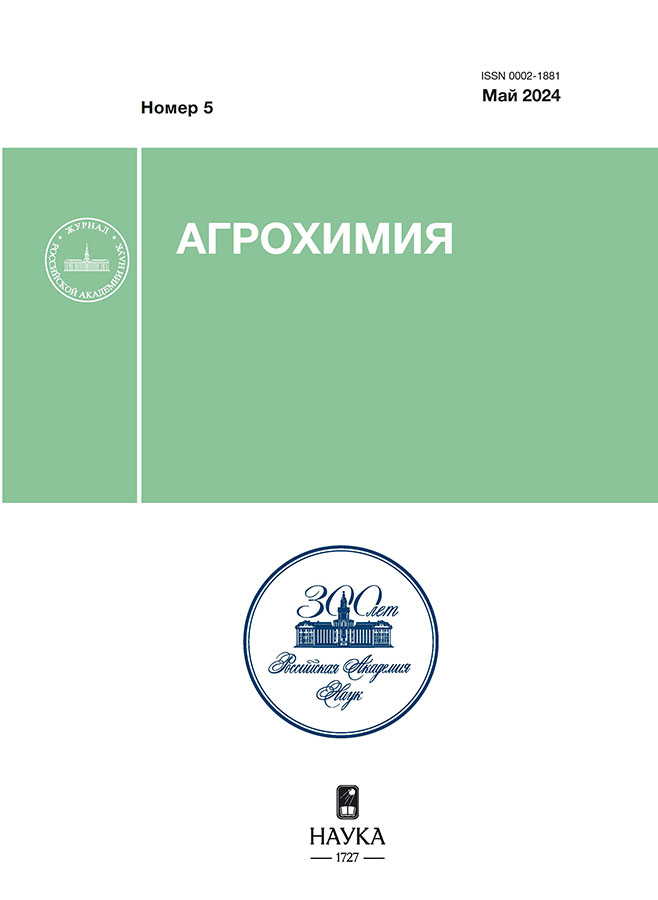CO2-emission from arable chernozems of western Nransbaikalia
- Authors: Chimitdorzhieva E.O.1, Tsybenov Y.B.1, Chimitdorzhieva G.D.1
-
Affiliations:
- Institute of General and Experimental Biology SB RAS
- Issue: No 5 (2024)
- Pages: 45-53
- Section: Agroecology
- URL: https://freezetech.ru/0002-1881/article/view/647188
- DOI: https://doi.org/10.31857/S0002188124050063
- EDN: https://elibrary.ru/CZCTTF
- ID: 647188
Cite item
Abstract
CO2-Emissions from agrochernozems of dispersed carbonate Tugnui basin and agrochernozems of quasi-clay Yeravninsky basin of western Transbaikalia were studied. To compare CO2-emissions from soils, the virgin land variants of the same name are taken. The aim of the study is to quantify and comparatively evaluate the production of carbon dioxide from arable chernozems with contrasting temperature and moisture conditions. The measurement of CO2 fluxes from the soil was carried out by a closed chamber method with a portable infrared CO2 gas analyzer AZ 7752 (AZ Instrument Corp., Taiwan). CO2-emissions were largely dependent on hydrothermal conditions. Its minimum at the beginning of the growing season was associated with the effect of low soil temperatures, the maximum was more often noted after precipitation. The peaks of CO2-emissions coincided with an increase in temperature and humidity from June to early August, in conditions of a lack of readily available moisture, and were also associated with a humidification regime. The limiting factor of the CO2 flux for quasi-clay chernozems was the soil temperature, for dispersed carbonate chernozems – humidity. It has been established that the total CO2-emission in arable soils is significantly less than in virgin soils, this is explained by the peculiarities of the agrogenic environment. Arable soils are warmer in summer, and they cool down more and deeper in winter. The transformation of the water regime occurs in the direction of reducing moisture and increasing its contrast during the warm period. The total carbon loss index varies in a series: dispersed-carbonate chernozem → quasi-clay chernozem, virgin soil → arable land.
Keywords
Full Text
About the authors
E. O. Chimitdorzhieva
Institute of General and Experimental Biology SB RAS
Author for correspondence.
Email: erzhena_ch@mail.ru
Russian Federation, 670047, Ulan-Ude, ul. Sakhyanovoy 6
Yu. B. Tsybenov
Institute of General and Experimental Biology SB RAS
Email: erzhena_ch@mail.ru
Russian Federation, 670047, Ulan-Ude, ul. Sakhyanovoy 6
G. D. Chimitdorzhieva
Institute of General and Experimental Biology SB RAS
Email: erzhena_ch@mail.ru
Russian Federation, 670047, Ulan-Ude, ul. Sakhyanovoy 6
References
- Ларионова А.А., Курганова И.Н., Лопес де Гереню В.О., Золотарева Б.Н., Евдокимов И.В., Кудеяров В.Н. Эмиссия диоксида углерода из агросерых почв при изменении климата // Почвоведение. 2010. № 2. С. 186–195.
- Заварзин Г.А., Кудеяров В.Н. Почва как главный источник углекислоты и резервуар органического углерода на территории России // Вестн. РАН. 2006. Т. 76. № 1. С. 14–29.
- Rustad L.E., Huntington T.G., Boone R.D. Controls on soil respiration: Implications for climate change // Biogeochemistry. 2000. V. 48. P. 1–6. https://doi.org/10.1023/A:1006255431298
- Наумов А.В. Дыхание почвы: составляющие, экологические функции, географические закономерности. Новосибирск: Изд-во СО РАН, 2009. 207 с.
- Post W.M., Mann L.K. Changes in soil organic car’ bon and nitrogen as a result of cultivation // Soils Greenhouse Еffect / Еd. A.F. Bouwman. N.Y.: John Wiley, 1990. P. 401–406.
- Davidson E.A., Ackerman I.L. Changes in carbon inventories following cultivation of previously untilled soils // Biogeochemistry. 1993. V. 20. P. 161–193.
- Титлянова А.А., Наумов А.В. Потери углерода из почв Западной Сибири при их сельскохозяйственном использовании // Почвоведение. 1995. № 11. С. 1357–1362.
- Курганова И.Н., Лопес Д.Г., Ипп С.Л., Каганов В.В., Хорошаев Д.А., Рухович Д.И., Сумин Ю.В., Дурманов Н.Д., Кузяков Я.В. Пилотный карбоновый полигон в России: анализ состояния почв и запасы углерода в лесной растительности // Почвы и окруж. среда. 2022. Т. 5. № 2. e169. https://doi.org/10.31251/pos.v5i2.169
- Кудеяров В.Н., Курганова И.Н. Дыхание почв России: анализ базы данных, многолетний мониторинг, общие оценки // Почвоведение. 2005. № 9. С. 1112–1121.
- Карелин Д.В., Замолодчиков Д.Г. Улеродный обмен в криогенных экосистемах. М.: Наука, 2008. 344 с.
- Классификация и диагностика почв СССР. М.а: Колос, 1977. 224 с.
- Классификация и диагностика почв России. Смоленск: Ойкумена, 2004. 342 с.
- IUSS Working Group WRB. International Union of Soil Sciences (IUSS), Vienna, Austria. 2022. Available online: https://wrb.isric.org/files/WRB_fourth_edition_2022–12–18.pdf (accessed 27 September 2023).
- Карелин Д.В., Почикалов А.В., Замолодчиков Д.Г., Гитарский М.Л. Факторы пространственно-временнóй изменчивости потоков СО2 из почв южнотаежного ельника на Валдае // Лесоведение. 2014. № 4. С. 56–66.
- Дугаров В.И., Куликов А.И. Агрофизические свойства мерзлотных почв. Новосибирск: Наука, СО, 1990. 255 с.
- Худяков О.И. Климат генетических горизонтов и его влияние на эмиссию СО2 мерзлотных и холодных почв // Эмиссия и сток парниковых газов на территории Северной Евразии. Пущино: ОНТИ ПНЦ РАН, 2004. С. 106–110.
- Волотовская Т.Н., Саввинов Г.Н. Биологическая активность мерзлотных лугово-черноземных почв долины р. Амга // Проблемы гидротермики мерзлотных почв. Новосибирск: Наука, СО, 1988. С. 37–40.
- Мендешев А., Жердева С.В. Динамика выделения СО2 орошаемыми степными почвами Северного Казахстана // Изв. АН КазССР. Сер. биол. 1989. № 1. С. 77–79.
Supplementary files













